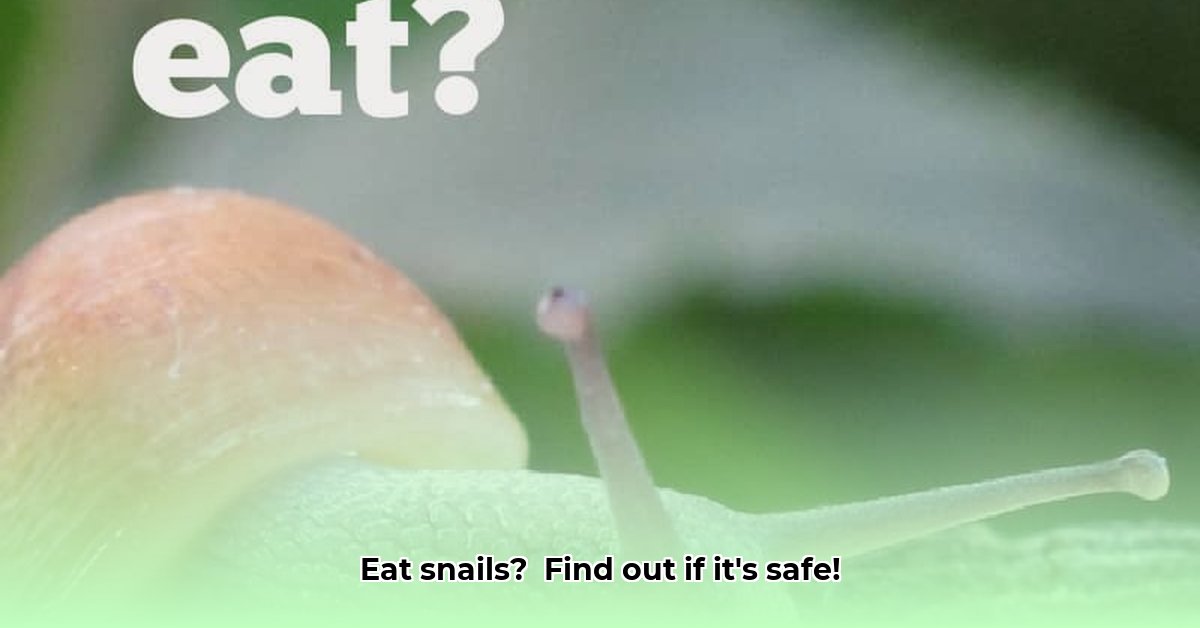Have you ever stopped to wonder if those garden snails might actually be good for you? It might sound strange, but in many cultures, snails are a delicacy! This comprehensive guide explores the world of edible snails, covering both the health benefits and the potential risks. We’ll break down their nutritional content, teach you how to identify edible snails (and which to avoid), and, most importantly, provide a detailed, step-by-step guide to cooking them safely. You’ll learn everything from sourcing to serving, empowering you to decide if snails deserve a place on your plate. For comparison, learn about the nutritional value of other seafood like snapper here.
Are Snails Healthy to Eat? Understanding the Potential and the Pitfalls
So, are snails a nutritional treasure or a potential health hazard? The truth, as with many foods, lies somewhere in between. Snails offer a unique blend of nutrients, but they also carry certain risks if not handled and prepared correctly. Let’s delve deeper into the world of snail consumption, exploring both the advantages and disadvantages, so you can make an informed decision about incorporating them into your diet.
A Nutritional Surprise: Exploring the Nutritional Composition of Edible Snails
Prepare to be surprised! Snails are more than just a slimy curiosity; they’re actually a surprisingly nutritious food source. They boast a high protein content, comparable to lean meats like chicken or fish, making them valuable for muscle building and repair. Moreover, snails are rich in essential minerals like iron, calcium, magnesium, and selenium, as well as vitamins like Vitamin A and B12. They’re a low-fat, nutrient-dense option that can contribute to a balanced diet.
Here’s a closer look at the typical nutritional content of a 100g serving of cooked snails:
| Nutrient | Approximate Amount (per 100g, Cooked) | % Daily Value | Key Benefits |
|---|---|---|---|
| Calories | 90 | Low in calories, making them a good option for weight management. | |
| Protein | 16g | 32% | Essential for building and repairing tissues, supporting immune function, and producing enzymes and hormones. |
| Fat | 1.5g | 2% | Low in fat, particularly saturated fat, contributing to heart health. |
| Carbohydrates | 2g | 1% | Provides energy for the body. |
| Iron | 3.5mg | 20% | Crucial for red blood cell production, oxygen transport, and preventing anemia. |
| Calcium | 170mg | 17% | Essential for strong bones and teeth, muscle function, nerve transmission, and blood clotting. |
| Magnesium | 250mg | 62% | Plays a vital role in over 300 biochemical reactions in the body, including muscle and nerve function, blood sugar control, and blood pressure regulation. |
| Selenium | 40mcg | 73% | A powerful antioxidant that protects cells from damage, supports thyroid function, and boosts the immune system. |
| Vitamin B12 | 1.5mcg | 25% | Essential for nerve function, red blood cell formation, and DNA synthesis. |
| Omega-3 Fatty Acids | Trace Amounts | Contribute to heart health, brain function, and reducing inflammation. |
It’s important to remember that these values can vary depending on the species of snail, their diet, and the cooking method used. However, this table provides a general overview of the nutritional benefits snails can offer.
Potential Health Benefits: Evaluating the Upsides of Consuming Snails (When Safe)
Given their impressive nutritional profile, incorporating snails into your diet could offer several health benefits, provided they are prepared and consumed safely. These potential benefits include:
- Improved Muscle Health: The high protein content supports muscle growth, repair, and maintenance.
- Enhanced Energy Levels: Iron helps prevent anemia and fatigue, boosting overall energy levels.
- Stronger Bones and Teeth: Calcium contributes to bone density and dental health.
- Boosted Immune System: Zinc and selenium support immune function and help fight off infections.
- Heart Health: Omega-3 fatty acids (in small amounts) may contribute to cardiovascular health.
However, it’s crucial to emphasize that these benefits are contingent upon proper preparation and safe handling practices. The risks associated with consuming improperly prepared snails far outweigh any potential health advantages.
The Dark Side: Understanding the Risks of Rat Lungworm and Other Concerns
The primary concern with eating snails is the risk of contracting rat lungworm disease, caused by the parasite Angiostrongylus cantonensis. Snails can become infected by ingesting rat feces containing the parasite larvae. If a human consumes a raw or undercooked infected snail, the parasite can migrate to the brain and spinal cord, causing eosinophilic meningitis. Symptoms can range from headaches, stiff neck, and fever to more severe neurological complications.
Beyond rat lungworm, other potential risks include:
- Bacterial Contamination: Snails can harbor harmful bacteria if not properly cleaned and cooked.
- Parasitic Infections: In addition to rat lungworm, other parasites can infect snails.
- Allergic Reactions: Some individuals may be allergic to snails, experiencing symptoms similar to shellfish allergies.
- Heavy Metal Contamination: Snails can accumulate heavy metals from their environment, posing a potential health risk if consumed in large quantities.
A Culinary Tightrope Walk: Cooking Snails Safely to Minimize Risks
Given the potential risks, it’s imperative to follow strict guidelines for sourcing, handling, and cooking snails to ensure their safety. Here’s a detailed, step-by-step guide:
Step 1: Sourcing Snails Responsibly:
- Choose Reputable Suppliers: Purchase snails from reputable suppliers who adhere to strict food safety standards and raise snails in controlled environments.
- Avoid Wild Snails (Generally): Wild snails carry a significantly higher risk of contamination with parasites and bacteria. Unless you are an expert in snail identification and can guarantee their safety, it’s best to avoid them.
- Know Your Species: Certain snail species are more commonly consumed and considered safer than others. Research the specific species you are considering and ensure it is known to be edible.
Step 2: Thorough Cleaning: A Meticulous Approach:
- Purge the Snails: Place the snails in a container with fresh water and a source of food (such as lettuce or vegetable scraps) for 24-48 hours to allow them to purge their digestive systems. Change the water regularly.
- Scrub Thoroughly: After purging, scrub the snail shells with a stiff brush under cold, running water to remove any dirt, debris, or slime. Pay close attention to crevices and hard-to-reach areas.
- Rinse Repeatedly: Rinse the snails thoroughly under cold, running water until the water runs clear.
Step 3: Blanching (Optional, but Recommended):
- Brief Boil: Briefly boil the snails in water for 2-3 minutes. This helps to kill surface bacteria and parasites.
- Drain and Rinse: Drain the snails and rinse them again under cold, running water.
Step 4: Cooking to Perfection: The Critical Step:
- Achieve a Safe Internal Temperature: The most crucial step is to cook the snails to an internal temperature of at least 165°F (74°C) for a minimum of 15 minutes to ensure that any potential parasites are killed.
- Use a Food Thermometer: Use a reliable food thermometer to verify the internal temperature. Insert the thermometer into the thickest part of the snail’s body.
- Cooking Methods: Snails can be cooked using various methods, including boiling, steaming, baking, or frying. Ensure that the chosen method allows for thorough and even cooking.
Step 5: Hygiene is Paramount: Preventing Cross-Contamination:
- Wash Hands Frequently: Wash your hands thoroughly with soap and water before and after handling snails.
- Clean Surfaces: Clean and sanitize all surfaces and utensils that have come into contact with snails.
- Avoid Cross-Contamination: Prevent cross-contamination by keeping snails separate from other foods.
Weighing the Scales: Making an Informed Decision About Snail Consumption
Before you decide to add snails to your menu, let’s summarize the key considerations:
Potential Benefits:
- Nutrient-rich source of protein, iron, calcium, and other essential vitamins and minerals.
- Low in fat and calories, making them a potentially healthy addition to a balanced diet.
- Unique flavor and texture that can add variety to your culinary experiences.
Potential Risks:
- Risk of rat lungworm disease if not cooked properly.
- Potential for bacterial contamination and other parasitic infections.
- Possible allergic reactions.
- Risk of heavy metal contamination (depending on the source).
- Many traditional recipes involve high-fat sauces and preparations, which can negate some of the health benefits.
Ultimately, the decision
- How Glass Bento Box Containers Make Meal Prep Easier - December 18, 2025
- Why Glass Boxes for Lunch Are Trending for Meal Prep - December 17, 2025
- Bento Box Glass Offers Practical, Eco-Friendly Meal Storage - December 16, 2025










